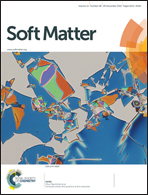Formation of thermally reversible optically transparent emulsion-based delivery systems using spontaneous emulsification
Abstract
Transparent emulsion-based delivery systems suitable for encapsulating lipophilic bioactive agents can be fabricated using low-energy spontaneous emulsification methods. These emulsions are typically fabricated from non-ionic surfactants whose hydrophilic head groups are susceptible to dehydration upon heating. This phenomenon may promote emulsion instability due to enhanced droplet coalescence at elevated temperatures. Conversely, the same phenomenon can be used to fabricate optically transparent emulsions through the phase inversion temperature (PIT) method. The purpose of the current study was to examine the influence of oil phase composition and surfactant-to-oil ratio on the thermal behavior of surfactant–oil–water systems containing limonene, medium chain triglycerides (MCT), and Tween 60. Various types of thermal behavior (turbidity versus temperature profiles) were exhibited by these systems depending on their initial composition. For certain compositions, thermoreversible emulsions could be formed that were opaque at high temperatures but transparent at ambient temperatures. These systems may be particularly suitable for the encapsulation of bioactive agents in applications where optical clarity is important.


 Please wait while we load your content...
Please wait while we load your content...